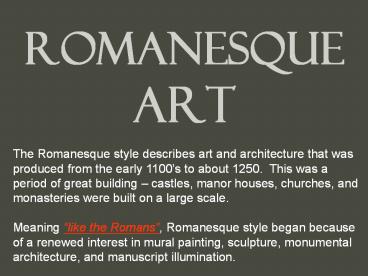Romanesque Art - PowerPoint PPT Presentation
1 / 25
Title: Romanesque Art
1
Romanesque Art
The Romanesque style describes art and
architecture that was produced from the early
1100s to about 1250. This was a period of great
building castles, manor houses, churches,
and monasteries were built on a large
scale. Meaning like the Romans, Romanesque
style began because of a renewed interest in
mural painting, sculpture, monumental
architecture, and manuscript illumination.
2
Illuminated Manuscript
- St. George and the Dragon
Ornamented initial with St. George, his squire
and the roaring dragons An image of
status Inclusion of a narrative within
the initial Fold partitions in the
skirts Represents a good example of the Medieval
costume St. Georges conquest of the
dragon symbolizes the suppression of a pagan cult
he was executed by Emperor Diocletian who was a
pagan
3
Romanesque Mural painting
Adoration of the Magi Apse fresco 11th century
- Partitioning of the draped figures into separate,
decoratively modeled segments - Pipe-like legs/ladder-like folds serve to keep
the figure flat and contributes to the effect of
still formality. - Figures are cut into patterns by hard outlines.
4
Romanesque Murals
- Flat
- Formal
- Hard Lines
5
Medieval Embroidery
The Bayeux Tapestry, 11c
20x230 embroidered fabric made of wool sewn on
linen Continuous, frieze-like pictorial
narrative of the Norman defeat of the
Anglo-Saxons at Hastings in 1066. Valuable
historical document Simplification of form
Exact description of arms and armor convincing
representation of action, pose, and gesture
The Battle Of Hastings - Scene 6
6
Romanesque Sculpture
The Prophet Jeremiah
Priory Church of Saint- Pierre
Moissac, France
His face has a humanly expression melancholy
and contemplative expression The figure is very
tall and thin stretched to accommodate the
pillar Drapery is incised with flowing
lines The sculptures crossed legs show an
awkward movement like a mechanical dance
7
Sculpture
- The Last Judgment
- Cathedral of Saint-Lazare, France
- 1120 1140
- Tympanum, area over the church entry door, with
sculpture that features the Last Judgment
http//www.youtube.com/watch?vuq1nUv0YOdg
Weighing of Souls
8
St. Trophime at Arles, FranceStatuary of the
Portals
- Artists interpretation of a Roman triumphal
arch (see next slide) - Tympanum shows Christ surrounded by
Evangelist - Lintel represents the twelve apostles in the
center of the continuous frieze that depicts
the Last Judgment - Saved on one side and damned on the other in
flames - Saints in the jambs and the front bays of the
portal - Sculpture simpler and more monumental to fit
with the architecture
9
RomanesqueCathedralArchitectural Style
- Rounded Arches
- Barrel vaults
- Thick walls
- Roof made of masonry instead of wood
- Darker, simplistic interiors
- Small windows, usually at the top of the wall
St. Sernin Toulouse, France
St. Sernin
10
Gothic Art
Italian Renaissance writers, who preferred
classical architecture, later described Gothic
buildings as ugly and created by barbarians
(Goths). This is how the incorrect term, Gothic,
was coined.
11
Gothic painting and sculpture
- Paintings and sculptures were made to look like
the actual model - Curving lines and careful detail were
emphasized - Paintings began to show a sense of depth as
painters - experimented with using perspective in their
artwork - Use of rich colors- including gold, seen in
altarpieces, painted wooden panels and
elaborately illustrated pages of manuscripts
12
Gothic paintingDeath of the Virgin
Intensity of emotion showing in the faces,
overlapping of figures, and detail in the
clothing was typical in Gothic painting.
13
The Book of Hours(Les Tres Riches Heures)
- most common type of surviving medieval
- illumination
- each book is unique, but all contain a
- collection of texts, prayers and psalms,
along - with illustrations
- reciting the hours typically centered upon the
- recitation or singing of a number of psalms,
- accompanied by set prayers
- The most famous of these were created by the
- Limbourg Brothers for the Duke of Berry at
- the beginning of the 15th century.
- Several of the miniatures depict the Duke, fields
or castles he owned, and places he visited. This
portrays the personal function of the book of
hours, as it is customized to suit the patron
August
14
Gothic Sculpture
Sculpture is still apart of the architecture but
it feels like it could stand alone. Believable
and sensual carvings Still portrays religious
meaning, but it becomes less symbolic and more
conveyed through true emotion and
realism Bending, swaying, smiling, talking
figures are the new style
St. Martin and St. Jerome c. 1220-1230 Chartres
Cathedral, France
15
Gothic sculpture
The Annunciation and The Visitation Jamb
statues over life-size
The Virgin of Paris Notre Dame, Paris
16
Chartres Cathedral, Magi
17
Cathedral Gargoyles
18
Notre Dame Cathedral, Paris
Gargoyles were sculpted to be used as water
spouts for medieval cathedrals. Originally
placed on cathedrals to direct water away from
the buildings foundation, they stir the
imagination to what other meanings they
may suggest or represent. A common belief is
that gargoyles served as protectors keeping
evil away from the buildings.
19
Gothic CathedralArchitectural Style
- Began in France in the 12c
- Pointed arches
- Flying buttresses
- Stained glass windows
- Elaborate, ornate interior
- Taller, more airy ? lots of light
- Lavish sculpture ? larger-than-life
20
Flying buttresses
21
Chartres CathedralParis, France
22
Notre Dame CathedralParis, France
23
Gothic Filigree Closeups
Filigree delicate lace-like, intertwined,
ornamental design.
24
Filigree
25
Stain Glass Windows
Rose window an example of radial symmetry































